

|
Home Updates Hydros Cars Engines Contacts Links ←Previous Contact On The Wire |
Ian & Ivy Moore
'A Formidable Partnership' (con't)
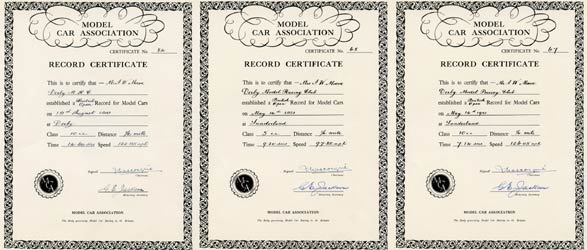
10cc 1/2 mile at 122.95mph. 5cc
1/4 mile 97.82mph. 10cc 1/4 mile 126.05mph
|
CAR #8 DOOLING McCOY RAILTON Leading up to this period, there had been a great deal of discussion about the use of foreign engines and cars rather than British and home produced items. Some were violently opposed and even retired from the sport. Others, such as Gerry Buck were very vocal, yet embraced both camps. Bill, having designed and built his own cars up to now, seems to have taken the 'if you can’t beat them, join them’ route. |
|
There seems to have been an influx of McCoy Railtons during the 1950 season and one headed to Derby. The ‘Special’ gave up its Dooling motor (not much of the original car left by now) and Bill had a new 10cc car for the season. Both the McCoy Invader and Railton used a separate gearbox, rather than the close-coupled arrangement as found in the Dooling Arrow and most of the other high-speed cars. Perhaps it was this that attracted Bill, as it was this very feature that formed the basis of his later highly successful 10s. Certainly he was very conscious of the need to change gear ratios to get the very best from his motors, which was next to impossible with the direct bevel drive arrangement.
Information about this car is scant, with only one reference to it in competition during the season and that was the Austin trophy at Eaton Bray. The Railton completed both its two runs at 102 mph, significantly slower than Gerry Buck’s winning 113mph with his McCoy powered C&C. Being beaten on such a regular basis, and by such a margin was not to Bill’s taste, and he now embarked on the most prolific building period of his career.
|
CAR #9 MOORE FOX SPECIAL Reports indicate that the Fox motor was very reluctant to start and, although a consistent runner when persuaded into life, it could not match the Dooling for pace. With another, more radical, 5cc car on the way, number 9 was surplus to requirements and was offered for sale in November 1951. |
|
|
CAR #10 SHADOW
For the 1952 season Bill made his first foray into the 2.5cc class. There was realistically only one choice of engine to be made, as the Oliver was carrying all before it in the 2,5cc category, and linered down proving unbeatable in the 1.5cc class as well. So a Tiger it was to be, but to avoid simply copying and trying to improve on the existing cars, a little lateral thinking was called for. |
|
The very small wheels in use for direct drive did not fill him with enthusiasm, as they reacted badly to bumps on the track. There was little room for alteration in tyre size to enable the motor to peak out, so where was the advantage? Perhaps spur drive was the answer, with larger tyres and the ability to change gear ratios.
Having obtained installation drawings from Olivers, various layouts were considered, but he kept coming back to the same conclusion. With an engine across the chassis, the pan would be too flat and the cross section too large. Perhaps a bevel drive, with the engine fore and aft would give the required reduction in size?
|
Finally, Bill decided to go with a Tiger Mk II aero engine, in a close-coupled bevel drive arrangement. However, in order to reduce the frontal area even further, the mounting lugs had to come off the engine. Howls of anguish were heard, as a hacksaw and large file were put into action. Further carnage ensued as the cylinder fins were filed to match. Now the car would be super slim, little wider than the crankcase of the motor. In order to reduce weight even further, the pan was designed as a ‘bobtail’ with just a thin extension for mounting the body and the tail skid. The motor was mounted via a split clamp on the nose of the crankcase and a block bolted to a solid back plate. |
|
A gear ratio of 1.5 to 1 was chosen with the pinion being mounted straight onto the crankshaft, dispensing with the flywheel completely. Rear wheels and tyres were McCoy Hornet Mites with smaller knife-edge fronts. An exceedingly thin body shell was carved from wood and then covered in doped silk. The finished car was just 1 5/16" wide.
|
|
Experimental runs showed up problems with the fuel system and choice of tyre size. Having addressed these, the car ran happily at 80+ mph. At this stage Bill realised that a great deal more fiddling was required to get the very best from the car and as he was heavily committed with other projects was not going to be able to give it the time required, so at the end of the season it was offered for sale. Of all the Moore cars, only two can be accounted for after he sold them, this one being bought by Stan Drayson from the Edmonton Club, who campaigned it successfully throughout the 53 season. |
An article detailing the construction of the car appeared in the Feb 53 issue of Model Maker and a set of plans were made available. Pan castings could be obtained directly from Bill, but interestingly, the castings he supplied had the pan handle attachment moved further forward. Note, casting are now available for this car again.
CAR #11 To borrow a Murrayism, car #II was identical to #10, except it was bigger. Bill’s last venture into the 5cc class was a simple scaling up from the Shadow to utilise the ubiquitous Dooling 29.
|
|
By 1952 the established practice was to use spur gears for the smaller classes as they were inherently more efficient, but never one to shirk a challenge in looking for an advantage, Bill decided that the smaller cross section, and better road holding might offset the lower efficiency of the bevel gears, so "just for a change" he thought he "would have a look at the idea of reverting to bevels". The pan was similar in most respects to the Shadow, but was a true ‘bobtail’ this time being squared off just behind the line of the tyres. Trans Atlantic howls of anguish emanated from Los Angeles as the Dooling also lost its mounting lugs. A split clamp on the crankcase nose held the motor in place at the front and a steel bracket at the rear picked up on the two lower back plate screws. Left: Bill working on number 12 with Bill Hamilton watching. Shadow in foreground and number 11 lurking behind |
A pair of 1.73:1 Rowell gears took the drive to 3" rear wheels and tyres. Again, with the car so narrow, the crown wheel was driven by pins from a flange machined onto the axle. Home brewed 2½" knife edge tyres looked after the front end. The car was topped off with a hand carved balsa and pine body of the same shape as #10. The original intention was to run the Dooling on spark ignition, but like many of his projects at this time, Bill never got ‘round tuit’ so it continued to run as a glow, with lead occupying the battery space. For all the work, the car was never as fast as the original 5cc Special. Best official time was 92.75 mph, although it did manage 95 in timed practice. It was fairly evident that the choice of tyre size and gearing was stopping the motor pulling top revs, but even so steady performances in the 90s was enough for a medal at the Midland Area Championships and a second at the Monza International meeting.
Model Maker published a three-view plan for the car, and in Dec 53 I.W.M described its construction. Pans were available from Bill, but with fairings added to avoid chopping the lugs of serviceable Doolings. He also decided that he could not do justice to 2 classes, let alone 3, so car #11 joined the Shadow in being sold off. It was advertised for sale in January 53.
|
CAR #12 ‘Record Breaker’ Although numbered twelve, this does not place the car correctly in the chronology, as it went through many incarnations and changes over a period from 1951. Although competitive, neither the 10cc Special or the Railton were ever quite fast enough for outright wins, so this car was designed and built to enable Bill to run with the quickest, and beat them. Right Battery and coil ignition. |
|
Although his early bevel drive cars were close coupled, experience with the Railton led him to believe that the separate pan and gearbox arrangement would offer significant advantages. Firstly it would simplify the accurate machining of the drive train, secondly it would allow a magneto to be fitted and thirdly, changes to gear ratios could be made easily. The bulk of the car is fairly standard, the pan and wheelbase having been extended slightly, to aid road holding, but the gearbox is fiendish by any standards. The drive train consisted of a set of 1.84:1 gears driving 3 7/8" wheels and tyres, which would ‘fling’ to about 4 1/2" at top revs. Initial testing showed that the magneto was not providing the sparks effectively so a quick conversion back to coil ignition was made before the trip to Sunderland for the Whit Monday Meeting.
|
Whit-week of 1951 was to prove a landmark for Bill as suddenly he had a car that
was humming. A new 1/4-mile record at Sunderland of 126.05 mph was 10% faster
than he had ever run previously and this was backed up at Osset the following
weekend with a 126.82 mph. This was a seriously quick car. Later still in the
season, a new 1/2 mile record of 122.9 mph was notched up by #12.
|
|
During the winter of 1951/52 the car was rebuilt to allow a change of gear ratio and the fitting of an effective magneto. These changes did not have the desired effect, as the car was slightly slower, although only by a couple of mph. Number 12 had to have a second rebuild in June 1952 after destroying itself at Ossett. Having just clocked 121 mph, the cable broke, and the car demolished the safety fence, coming to rest some 100ft from the track. Time was of the essence as Bill was due in Monza for the International meeting. Only the pan, engine and gearbox survived, yet the car was running again in 3 weeks for the trip to Italy, where it tied for 2nd place in the class. Again Model Maker published detailed plans for the car and it featured as a constructional series from April 1953.
|
CAR #14 The last of the ‘Ian Moore’ cars, essentially the same as 12, with a few refinements. The only obvious identifying feature being the front wheels and tyres. The career of this car in IWMs hand came to an end in 1954 with International meetings in Switzerland and Italy. In Landikon the car recorded a 194 kph to set a new European record, which was backed up with a 175 kph to take class honours in Monza, beating fellow countryman Jim Dean on each occasion. |
|
|
|
Having decided to retire from racing, number 12 was advertised for sale in November of that year. This is the second of his cars that had a post Moore history, as it was bought by Swiss enthusiast Philip Rochat and run very successfully for the next two years, his best run being 124 mph. The Dooling motor expired at Monza in 1956, when the piston disintegrated. In 20 years Moore progressed from clockwork to British and European record holder with what was certainly one of the fastest home built cars of the era. Left: #14 with the 10cc class Trophy won at Monza in 1954 |
|
Unfortunately none of his cars are currently known to exist, although there are replicas about, and at least three Shadows are currently under construction. His pitbox with the M logo survived until it was inadvertently put in a skip in 2007. Right: The box, with number 14 at the Gamston track of the Nottingham Club around 1953. |
|
Replica 'Ian Moore' Cars
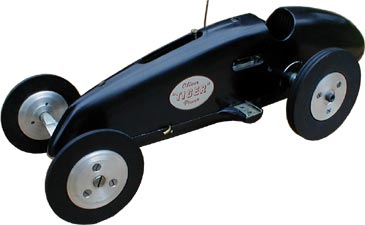 |
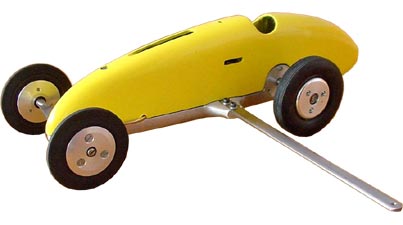 |
| John Oliver's Shadow. Oliver 2.5cc | Shadow by Ivan Prior. CS 2.5cc |
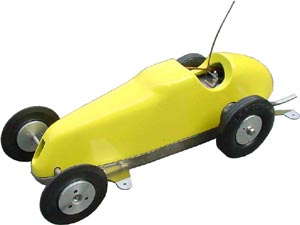 |
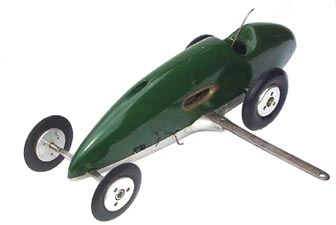 |
| Original 'Special', modern body. Nordec 10cc | Complete and original number 12. Dooling 61 |
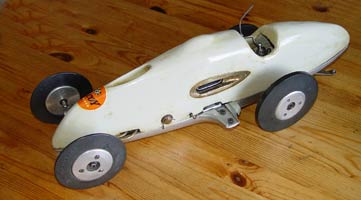 |
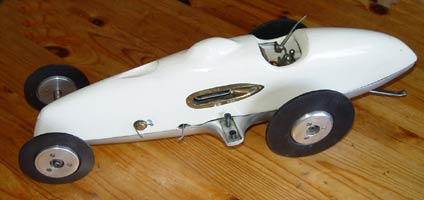 |
| Number 12s built by Les Williamson in the 1950s. McCoy 61 on left, Dooling 61 on right | |
 |
 |
| 1950s 'Dooling Specials' from Les Williamson. Dooling 29 on left, ETA 29 on right | |
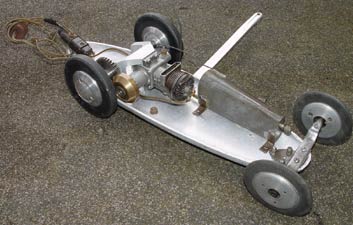 |
 |
| Pair of 'Dooling Specials', both ETA 29 powered originating from the Ossett Club. Sold on ebay | |
Thanks go to Peter Hill, Roger Allton, Dave Coe, Eric Offen and Bill Langley for additional photos used in this article. Thanks also to Ron Reiter for providing the original certificates and original photos.
©copyrightOTW2012